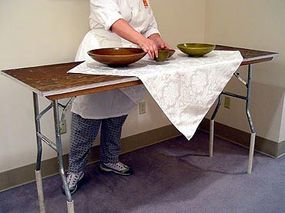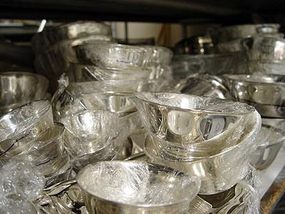Catering: Set-up, Service and Clean-up
The big day has arrived. This is when the catering team finally puts the itinerary to use. It's time to load up all the equipment, supplies and foodstuffs. Working from an extensive packing list, the crew loads vans and trucks with all the supplies. Nothing goes unchecked - the crew accounts for every linen, glass, chafing dish, tray, pot, pan and silver piece on the packing list. They even itemize small items like aluminum foil, saran wrap and garbage bags. The team at Joel has a 14-foot truck to move equipment and supplies from their premises to the event site. The crew loads the heavy stuff first -- ovens, fryers and hot boxes -- followed by tables, pots and pans, glassware, china and serving pieces. Finally, when everything else is on board, they load the food.
At this point, you might be thinking, "Back-up there a minute -- did you say ovens?" Yes, ovens! Caterers use an array of portable appliances and heavy equipment -- ovens, fryers, hot boxes and dishwashers to name a few. For example, Joel uses industrial convection ovens that have been put on wheels and converted from natural gas to propane for mobility. One tank of propane provides enough power for five hours of cooking time. Complete with burners for stove-top cooking, each oven cavity can accommodate four sheet pans of food. That may not sound like a lot, but at forty 8-ounce filets per sheet pan, that's 160 steaks!
Advertisement

The Set-up
The catering crew transports the supplies to the event site and unloads it all. If the site has cooking facilities, the crew unloads the cooking equipment (pots, pans, serving dishes, etc.) and food right away. Then they set up the tables and chairs, according to the precise floor plan. Typically, the client services representative or coordinator that planned the event manages all the setup work. Sometimes, the firm has to execute this front-house setup in concert with other vendors. This is where the detailed schedule, floor-plan and layout come in handy. Thanks to the detailed plan, the florist knows where to place arrangements, the musicians know where to set up their instruments, and so on.

For an outdoor event without cooking facilities, things get a little more interesting: The crew has to assemble a temporary kitchen immediately. The team divides the tents into two staging areas, one for presentation and serving and one for cooking. A hanging wall separates the two areas of each tent. On the kitchen side, tables line the outside walls and run down the center. The crew also sets up the ovens, hotboxes and other equipment. Hot boxes are large insulated steel booths lined with racks that can hold 40 to 50 sheet pans of food. The kitchen staff uses sterno cups, small cups of inflammable gel, to keep the hot boxes warm. Once lit, a sterno cup will burn for about 4 hours.
If the caterer is serving the food buffet style, the crew will set up stations with serving platters and chafing dishes around the event. The kitchen staff cooks and prepares the food and buffet attendants and runners keep the stations stocked. Sterno cups keep food warm and dry ice keeps food cold. For example, at a dessert station, the team at Joel will use dry ice wrapped in linen to support a ceramic serving bowl of ice cream. This prevents the ice cream from melting for three, possibly four hours.
Large seated dinners require even more staff and organization. For these events, Joel uses something called the "T formation." Basically, they set up prep tables in the shape of a T. Kitchen staff flanks the center-column table, with one person per item on each side. As the crew passes plates from the base of the "T" up to the top, each person adds one part of the meal. Once the plates reach the top of the "T", the final person in the line garnishes them, and the waitstaff brings them to the guests. This assembly line method keeps the kitchen from becoming too congested with people moving about.

The Service
Different functions call for different types of service. For example, for a cocktail buffet, the team at Joel uses this formula to decide what the staffing needs are:
- 1 Coordinator per event
- 1 Supervisor per event
- 1 Waiter per 30 - 50 people
- 1 Steward per 100 people
- 1 Buffet Attendant per buffet / station
- 1 Runner per buffet / station
- 1 Bartender per 75 people
- 1 Kitchen Manager per buffet station
So, a cocktail buffet for 150 people with seven buffet stations would have a service staff consisting of three to five waiters, seven buffet attendants, seven runners, one or two stewards and two bartenders. The coordinator or event supervisor meets with the service staff to go over their duties. Some will be manning the buffet stations, some will circulate through the event serving hors d'oeuvres and others will run food from the kitchen to the buffet and bus dishes. With everyone properly informed of their responsibilities, the event should run smoothly. Throughout the event, the coordinator continues to oversee each phase, making sure the detailed schedule is strictly followed.

The Clean-up
After the function is over, it's time to clean everything, break down all the equipment and tables and pack it all up to go back to the catering premises. The crew breaks out the original packing list to make sure they account for everything. As with every other stage of the function, the team has to execute the clean-up meticulously. The caterer's goal is to leave the space as clean -- if not cleaner, than they found it. The team washes supplies such as glassware, silver and dishes and wraps them for storage. They identify and clean all rented supplies, and return them to the rental agency.


As you can see, catering can be an exciting career that requires creativity and excellent organizational and people skills. Let's take a look at what you can do to prepare for a career in catering.
